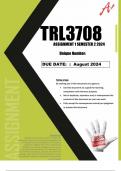TRL3708 ASSIGNMENT 1 SEMESTER 2 2024
Unique Number:
DUE DATE: : August 2024
Terms of use
By making use of this document you agree to:
Use this document as a guide for learning,
comparison and reference purpose,
Not to duplicate, reproduce and/or misrepresent the
contents of this document as your own work,
Fully accept the consequences should you plagiarise
or misuse this document.
Disclaimer
Extreme care has been used to create this
document, however the contents are provided “as
is” without any representations or warranties,
express or implied. The author assumes no
liability as a result of reliance and use of the
contents of this document. This document is to
be used for comparison, research and reference
purposes ONLY. No part of this document may be
reproduced, resold or transmitted in any form or
by any means.
, 0688120934
PREVIEW
Question 1: Logistics Systems in the Health Sector
1.1 Supply Chain Information Systems (SCIS) and Competitive Advantage
Supply Chain Information Systems (SCIS) are integral to enhancing the efficiency and
effectiveness of supply chains by providing real-time data and enabling informed
decision-making. These systems are crucial in streamlining processes, reducing costs,
and improving service levels, thereby providing a competitive advantage. SCIS includes
various components such as Enterprise Resource Planning (ERP), Advanced Planning
Systems (APS), and Warehouse Management Systems (WMS), all of which play distinct
roles in the supply chain.
SCIS can significantly enhance the World Health Organization's (WHO) operations and
the South African health sector by providing a comprehensive view of the supply chain,
improving coordination between various stakeholders, and ensuring the timely delivery of
medical supplies. By integrating SCIS into their operations, WHO can monitor and
manage the flow of goods from suppliers to end-users more efficiently. This system
enables the tracking of inventory levels, order processing, and shipment schedules, which
are critical for maintaining an uninterrupted supply chain.
Disclaimer
Extreme care has been used to create this document, however the contents are provided “as is”
without any representations or warranties, express or implied. The author assumes no liability as
a result of reliance and use of the contents of this document. This document is to be used for
comparison, research and reference purposes ONLY. No part of this document may be
reproduced, resold or transmitted in any form or by any means.




